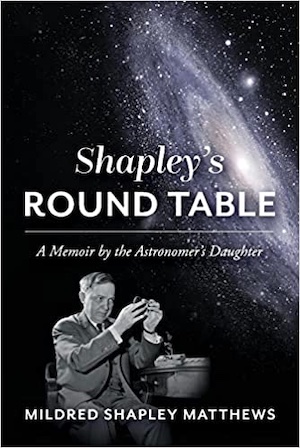By Jay M. Pasachoff
It sounds like fun: life at the Harvard College Observatory in the first half of the 20th century. Harlow Shapley as director, and the Director’s Residence (adjacent to the famous 19th-century telescope) sheltering his family (his wife, Martha Betz Shapley, also was a productive contributor to the astronomical output), with other famous astronomers like Annie Cannon in and out of the residence along with the children. The Director’s Residence has long since been torn down, but the legacy of the 30-year directorship of Harlow Shapley remains.
The Shapleys’ daughter, Mildred (ΦBK, University of Michigan), who was a long-time editor at the University of Arizona’s series of solar-system books, wrote this memoir about 60 years ago, and it is only this year that her daughter June Lorraine Matthews, a retired MIT physics professor, working with heliophysicist and administrator Tom Bogdan, brought the memoir to distribution. The 30 pages of descriptions and notes, largely by Bogdan, add to the readability, and the 10-page Appendix by Harvard astronomer/historian-of-science Owen Gingerich on “Harlow Shapley’s Impact” helps readers fit Shapley in context.
Coincidentally, a listing this month in Astronomy Magazine of the 20 greatest astronomers of all time had Shapley at number nine! My elementary astronomy students learn who he was, but why isn’t he better known in the 21st century? His name surfaces most often, I think, in the references to the “debate” at the National Academy of Sciences in the 1920s, including the publications that followed the after dinner talks, as to whether the “spiral nebulae” known in the sky were individual “island universes,” or not. We now know that they are indeed individual galaxies, so Shapley came to the wrong conclusion then, though with superior reasoning to his opponent’s. One of the chapters deals with this scientific matter, though the bulk of the book is non-scientific.
Shapley is credited with noticing that his measurements of globular clusters of stars showed that almost all of them were in the same part of the sky, and concluding that the center of the Milky Way Galaxy must be over there. Thus, as Copernicus took the Earth out of the center of the Universe, Shapley took the Sun and the Solar System out of the center of the Universe.
When I was a Bronx High School of Science student in the 1950s grinding and polishing a 6″ f/8 Newtonian reflecting telescope mirror at the Amateur Astronomers Association’s Optical Division, I recall that Director Dick Luce had a poem posted. I hadn’t realized that it was from the 1879 Observatory Pinafore that was resurrected for New Year’s Eve 1929. The current book quotes the Gilbert & Sullivan parody for several (seven) pages, to our delight:
He must open the dome and turn the wheel,
And watch the stars with untiring zeal.
He must toil at night though cold it be,
And he never should expect a decent salaree.
Just two anecdotes selected from the book: my favorite is when Jawaharlal Nehru came to Harvard and was feted by deans and other higher-ups. But after lunch and additional festivities, when asked what he wanted to do next, Nehru said that he wanted to go to the observatory to see Shapley!
In his later years, Shapley was a major internationalist, getting him in trouble with the House Un-American Activities Committee, though he was defended back at Harvard. He was instrumental in setting up UNESCO, pointing out that the proposed United Nations Economic and Cultural Organization didn’t properly credit Science—so he is credited with the S in UNESCO.
Shapley’s circular desk, rotating so different projects could come to the fore, survives in the home of current historians of astronomy, as do the tall dining chairs that had been left in the Residence by the Shapleys’ predecessor, Edward Pickering. I remember as a Harvard Observatory student in the 1960s participating in a “Hollow Square,” in which Shapley made one of his rare visits to Cambridge from retirement in New Hampshire, with scientific discussions from a variety of participants.
Just yesterday, I heard of an astronomer’s daughter in a law school class taught by one of my own daughters. One wonders how long we will be remembered by future generations; the Shapleys have a distinguished and widespread distribution.
I enjoyed reading Shapley’s Round Table and recommend it to all.
See also HarlowShapley.com
Astronomer and author Jay M. Pasachoff (ΦBK, Williams College) is the director of the Hopkins Observatory and Field Memorial Professor of Astronomy at Williams College. He is a visitor in the Carnegie Observatories. Williams College is home to the Gamma of Massachusetts chapter of Phi Beta Kappa.




